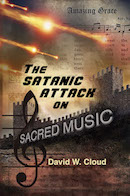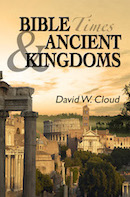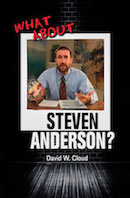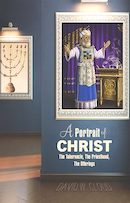866-295-4143, fbns@wayoflife.org
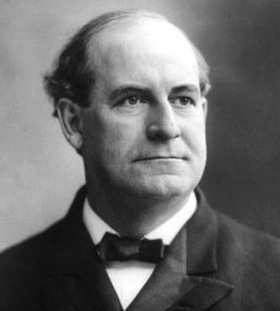
William Jennings Bryan
THE SCOPES TRIAL
The Scopes trial of 1925 is a major evolutionary icon, but the way it is typically presented is a myth. The 1960 Hollywood movie Inherit the Wind staring Spencer Tracy is a cheap propaganda piece.
The trial was to determine whether John Scopes was guilty of teaching evolution in a public school classroom contrary to Tennessee state law. (The law forbade any state-funded educational establishment of “any theory that denies the story of the Divine Creation of man as taught in the Bible and to teach instead that man has descended from a lower order of animals.)
The trial was arranged as a showcase by the American Civil Liberties Union in their agenda to dethrone the Bible from a position of authority in American society.
Criminal lawyer Clarence Darrow, an atheist and a profane man who was willing to use any trick to defend the guilty, was chief defense attorney. (Darrow was tried twice for bribery and forbidden to practice law in California. A year before the Scopes Trial he had defended the wealthy teenage killers Leopold and Leob who murdered 14-year-old Bobby Franks just for “a sort of pure love of excitement.” Darrow saved them from the death penalty with psychological mumbo-jumbo about their not being accountable for their actions.)
William Jennings Bryan, a three-time presidential candidate and very outspoken defender of the Bible, assisted with the prosecution.
In History of Modern Creationism, Dr. Henry Morris observed,
“The Scopes trial was evolution’s great triumph (greater even than the famed Huxley-Wilberforce debate)...” (p. 76).
Dr. Morris said that when he spent six weeks speaking on creationism in New Zealand in 1973, the government-controlled television channels broadcast Inherit the Wind repeatedly in each city he visited (History of Modern Creationism, p. 77).
The trial was a great media event. It was covered by more than 200 reporters who wrote about two million words. Sixty-five telegraph operators “sent out more words to Europe and Australia than had ever before been cabled about any American event” (R.M. Cornelius, Scopes: Creation on Trial, p. 10). It was the first trial to be broadcast nationally on radio (by station WGN in Chicago).
Most of the reporting was highly biased against creationism. It was “specifically designed to destroy creationism and the fundamentalist revival which reached its climax in this media event” (Morris, p. 70). When asked why he never attended the trial sessions, one reporter answered, “Oh, I don’t have to know what’s going on; I know what my paper wants me to write” (Warren Allem, Backgrounds of the Scopes Trial, p. 92).
The image typically portrayed of William Jennings Bryan is of a sincere but bumbling and not very intelligent man, but this is nonsense. Bryan was called “The Great Commoner” because he had a heart for the common man and a gift of communicating truth in a simple way, but he was a very intelligent, studious man. The book In His Image (1922) contains the James Sprunt Lectures that Bryan delivered at Union Theological Seminary. The invitation to deliver these prestigious lectures is evidence of Bryan’s intellectual stature. Previous lectures had been delivered by such men as J. Gresham Machen and G. Campbell Morgan. In the James Sprunt Lectures, Bryan delivered a carefully-reasoned presentation on such questions as the existence of God, the divine inspiration of the Bible, and the soul of man. From a reading of these lectures, it is obvious that he was an intelligent, well-read man.
In his discussion of Darwinism, Bryan made the following observation:
“But the Darwinian doctrine is more dangerous because more deceptive. It permits one to believe in a God, but puts the creative act so far away that reverence for the Creator--even belief in Him--is likely to be lost” (In His Image, p. 90).
That is a brilliant observation which I have never heard stated by anyone else, though I have read at least 70 books on both sides of the creationism/evolution debate.
It is obvious that Bryan had read Darwin’s two major works and had understood them. His critique is devastating. Consider this:
“Darwin does not use facts; he uses conclusions drawn from similarities. He builds upon presumptions, probabilities and inference, and asks the acceptance of his hypothesis ‘notwithstanding the fact that connecting links have not hitherto been discovered.’ He advances an hypothesis which, if true, would find support on every foot of the earth’s surface, but which, as a matter of fact, finds support nowhere” (In His Image, p. 91).
This described the vacuity of Darwin’s arguments perfectly.
The reason that Bryan was so hated by evolutionists in his day was that his arguments against Darwinism were effective. The same was true for Samuel Wilberforce before him.
Having said that, Bryan made a serious error in holding to the day/age theory and thus allowing for the possibility of million of years of time for creation to occur.
“Probably the most serious mistake made by Bryan on the stand was to insist repeatedly that he had implicit confidence in the infallibility of Scripture, but then to hedge on the geological question, relying on the day/age theory. He had been warned against this very thing by George McCready Price. Darrow, of course, made the most of it, ridiculing the idea of people claiming to believe the Bible was inspired when its meaning was so flexible that one could make it say whatever he wished” (Morris, p. 73).
Though evolutionists try to portray Bryan and all Bible believers as ignorant people, blindly following a mythical religion, it was actually the evolutionists at the trial that introduced myths into the court record and turned out to be complete fools (though this is almost never reported by the mainstream media).
Nebraska Man and Piltdown Man were mentioned at the trial in affidavits by “expert witnesses” Fay-Cooper Cole and Horatio Newman (professors at the University of Chicago), and Judge Raulston allowed their reports to be read into the court record on July 20, 1925.
Nebraska Man was a supposed missing link between apes and man that had been announced in 1922 by Henry Osborn, president of the American Natural History Museum. In June of that year, the popular and influential Illustrated London News published a two-page black and white drawing of Nebraska Man based on collaboration with Grafton Elliot Smith of the British Natural History Museum. The drawing depicts Mr. and Mrs. Nebraska Man. They are stooped and naked, human in body but somewhat ape-like in the face. The brutish caveman holds a club while his “wife” holds some small animal while looking at the male with a very stupid expression on her unattractive ape face. A couple of months before the Scopes Trial, Henry Osborn wrote that Nebraska Man “constitutes infinitesimal but irrefutable evidence that the man-ape wandered over from Asia into North America” (The Forum, May 1925). The problem was that Nebraska Man was based upon a single tooth that was later found to belong to a pig.
As for Piltdown Man, this missing link turned out to be a complete hoax. Doctored fragments of a 500-year-old human skull, an orangutan jawbone, and a couple of chimpanzee teeth “discovered” in the Piltdown gravel pit in Sussex in 1912 were accepted by experts at the British Museum and elsewhere as an ancient ape-man. It was given the scientific name of Eoanthropus dawsoni (“Dawson’s dawn-man”) in honor of its discoverer Charles Dawson (who probably perpetrated the hoax). For 40 years, Piltdown Man was broadcast throughout the world as a major evidence of evolution and used to silence Bible believers. A plaster reconstruction was given a prominent place in the British Museum of Natural History. Drawings, paintings, and statues of Piltdown proliferated. The one by Louis Rutot, titled “Man of Sussex,” depicted Piltdown as an ape-man (a half-ape, half-human head on a hairy human body) making a crude tool. Piltdown was adopted into textbooks, described in encyclopedias, represented at museums, introduced as evidence in the Scopes Trial, and discussed in hundreds of articles and scientific papers. Arthur Woodward of the British Museum devoted an entire book, The Earliest Englishman, to Piltdown. Finally in 1953, the British Museum announced that the “fossils” had proven to be fabricated.
Even though the Scopes Trial was won by the creationists (in the end Scopes pled guilty of teaching evolution contrary to state law) and even though the evidence for evolution introduced at the trial turned out to be entirely bogus, it had the dramatic effect of furthering evolution and “intimidating Christians.”
“Multitudes of nominal Christians capitulated to theistic evolution, and even those who retained their belief in creation retreated from the arena of conflict” (Morris, p. 74).
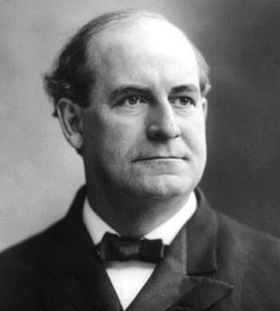
Evolutionists have created two great iconic myths to support their boast that evolution has won over the Bible and Christianity. The first is the Wilberforce-Huxley “debate” of 1860. The second is the Scopes Trial of 1925. [Pictured: William Jennings Bryan]
THE SCOPES TRIAL
The Scopes trial of 1925 is a major evolutionary icon, but the way it is typically presented is a myth. The 1960 Hollywood movie Inherit the Wind staring Spencer Tracy is a cheap propaganda piece.
The trial was to determine whether John Scopes was guilty of teaching evolution in a public school classroom contrary to Tennessee state law. (The law forbade any state-funded educational establishment of “any theory that denies the story of the Divine Creation of man as taught in the Bible, and to teach instead that man has descended from a lower order of animals.)
The trial was arranged as a showcase by the American Civil Liberties Union in their agenda to dethrone the Bible from a position of authority in American society.
Criminal lawyer Clarence Darrow, an atheist and a profane man who was willing to use any trick to defend the guilty, was chief defense attorney. (Darrow was tried twice for bribery and forbidden to practice law in California. A year before the Scopes Trial he had defended the wealthy teenage killers Leopold and Leob who murdered 14-year-old Bobby Franks just for “a sort of pure love of excitement.” Darrow saved them from the death penalty with psychological mumbo-jumbo about their not being accountable for their actions.)
William Jennings Bryan, a three-time presidential candidate and very outspoken defender of the Bible, assisted with the prosecution.
In History of Modern Creationism, Dr. Henry Morris observed,
“The Scopes trial was evolution’s great triumph (greater even than the famed Huxley-Wilberforce debate)...” (p. 76).
Dr. Morris said that when he spent six weeks speaking on creationism in New Zealand in 1973, the government-controlled television channels broadcast Inherit the Wind repeatedly in each city he visited (History of Modern Creationism, p. 77).
The trial was a great media event. It was covered by more than 200 reporters who wrote about two million words. Sixty-five telegraph operators “sent out more words to Europe and Australia than had ever before been cabled about any American event” (R.M. Cornelius, Scopes: Creation on Trial, p. 10). It was the first trial to be broadcast nationally on radio (by station WGN in Chicago).
Most of the reporting was highly biased against creationism. It was “specifically designed to destroy creationism and the fundamentalist revival which reached its climax in this media event” (Morris, p. 70). When asked why he never attended the trial sessions, one reporter answered, “Oh, I don’t have to know what’s going on; I know what my paper wants me to write” (Warren Allem, Backgrounds of the Scopes Trial, p. 92).
The image typically portrayed of William Jennings Bryan is of a sincere but bumbling and not very intelligent man, but this is nonsense. Bryan was called “The Great Commoner” because he had a heart for the common man and a gift of communicating truth in a simple way, but he was a very intelligent, studious man. The book In His Image (1922) contains the James Sprunt Lectures that Bryan delivered at Union Theological Seminary. The invitation to deliver these prestigious lectures is evidence of Bryan’s intellectual stature. Previous lectures had been delivered by such men as J. Gresham Machen and G. Campbell Morgan. In the James Sprunt Lectures, Bryan delivered a carefully-reasoned presentation on such questions as the existence of God, the divine inspiration of the Bible, and the soul of man. From a reading of these lectures, it is obvious that he was an intelligent, well-read man.
In his discussion of Darwinism, Bryan made the following observation:
“But the Darwinian doctrine is more dangerous because more deceptive. It permits one to believe in a God, but puts the creative act so far away that reverence for the Creator--even belief in Him--is likely to be lost” (In His Image, p. 90).
That is a brilliant observation which I have never heard stated by anyone else, though I have read at least 70 books on both sides of the creationism/evolution debate.
It is obvious that Bryan had read Darwin’s two major works and had understood them. His critique is devastating. Consider this:
“Darwin does not use facts; he uses conclusions drawn from similarities. He builds upon presumptions, probabilities and inference, and asks the acceptance of his hypothesis ‘notwithstanding the fact that connecting links have not hitherto been discovered.’ He advances an hypothesis which, if true, would find support on every foot of the earth’s surface, but which, as a matter of fact, finds support nowhere” (In His Image, p. 91).
This described the vacuity of Darwin’s arguments perfectly.
The reason that Bryan was so hated by evolutionists in his day was that his arguments against Darwinism were effective. The same was true for Samuel Wilberforce before him.
Having said that, Bryan made a serious error in holding to the day/age theory and thus allowing for the possibility of million of years of time for creation to occur.
“Probably the most serious mistake made by Bryan on the stand was to insist repeatedly that he had implicit confidence in the infallibility of Scripture, but then to hedge on the geological question, relying on the day/age theory. He had been warned against this very thing by George McCready Price. Darrow, of course, made the most of it, ridiculing the idea of people claiming to believe the Bible was inspired when its meaning was so flexible that one could make it say whatever he wished” (Morris, p. 73).
Though evolutionists try to portray Bryan and all Bible believers as ignorant people, blindly following a mythical religion, it was actually the evolutionists at the trial that introduced myths into the court record and turned out to be complete fools (though this is almost never reported by the mainstream media).
Nebraska Man and Piltdown Man were mentioned at the trial in affidavits by “expert witnesses” Fay-Cooper Cole and Horatio Newman (professors at the University of Chicago), and Judge Raulston allowed their reports to be read into the court record on July 20, 1925.
Nebraska Man was a supposed missing link between apes and man that had been announced in 1922 by Henry Osborn, president of the American Natural History Museum. In June of that year, the popular and influential Illustrated London News published a two-page black and white drawing of Nebraska Man based on collaboration with Grafton Elliot Smith of the British Natural History Museum. The drawing depicts Mr. and Mrs. Nebraska Man. They are stooped and naked, human in body but somewhat ape-like in the face. The brutish caveman holds a club while his “wife” holds some small animal while looking at the male with a very stupid expression on her unattractive ape face. A couple of months before the Scopes Trial, Henry Osborn wrote that Nebraska Man “constitutes infinitesimal but irrefutable evidence that the man-ape wandered over from Asia into North America” (The Forum, May 1925). The problem was that Nebraska Man was based upon a single tooth that was later found to belong to a pig.
As for Piltdown Man, this missing link turned out to be a complete hoax. Doctored fragments of a 500-year-old human skull, an orangutan jawbone, and a couple of chimpanzee teeth “discovered” in the Piltdown gravel pit in Sussex in 1912 were accepted by experts at the British Museum and elsewhere as an ancient ape-man. It was given the scientific name of Eoanthropus dawsoni (“Dawson’s dawn-man”) in honor of its discoverer Charles Dawson (who probably perpetrated the hoax). For 40 years, Piltdown Man was broadcast throughout the world as a major evidence of evolution and used to silence Bible believers. A plaster reconstruction was given a prominent place in the British Museum of Natural History. Drawings, paintings, and statues of Piltdown proliferated. The one by Louis Rutot, titled “Man of Sussex,” depicted Piltdown as an ape-man (a half-ape, half-human head on a hairy human body) making a crude tool. Piltdown was adopted into textbooks, described in encyclopedias, represented at museums, introduced as evidence in the Scopes Trial, and discussed in hundreds of articles and scientific papers. Arthur Woodward of the British Museum devoted an entire book, The Earliest Englishman, to Piltdown. Finally in 1953, the British Museum announced that the “fossils” had proven to be fabricated.
Even though the Scopes Trial was won by the creationists (in the end Scopes pled guilty of teaching evolution contrary to state law) and even though the evidence for evolution introduced at the trial turned out to be entirely bogus, it had the dramatic effect of furthering evolution and “intimidating Christians.”
“Multitudes of nominal Christians capitulated to theistic evolution, and even those who retained their belief in creation retreated from the arena of conflict” (Morris, p. 74).
- Receive these reports by email
- www.wayoflife.org
______________________
Sharing Policy: Much of our material is available for free, such as the hundreds of articles at the Way of Life web site. Other items we sell to help fund our expensive literature and foreign church planting ministries. Way of Life's content falls into two categories: sharable and non-sharable. Things that we encourage you to share include the audio sermons, O Timothy magazine, FBIS articles, and the free eVideos and free eBooks. You are welcome to make copies of these at your own expense and share them with friends and family. You may also post parts of reports and/or entire reports to websites, blogs, etc as long as you give proper credit (citation). A link to the original report is very much appreciated as the reports are frequently updated and/or expanded. Things we do not want copied and distributed are "Store" items like the Fundamental Baptist Digital Library, print editions of our books, electronic editions of the books that we sell, the videos that we sell, etc. The items have taken years to produce at enormous expense in time and money, and we use the income from sales to help fund the ministry. We trust that your Christian honesty will preserve the integrity of this policy. "For the scripture saith, Thou shalt not muzzle the ox that treadeth out the corn. And, The labourer is worthy of his reward" (1 Timothy 5:18). Questions? support@wayoflife.org
Goal:Distributed by Way of Life Literature Inc., the Fundamental Baptist Information Service is an e-mail posting for Bible-believing Christians. Established in 1974, Way of Life Literature is a fundamental Baptist preaching and publishing ministry based in Bethel Baptist Church, London, Ontario, of which Wilbert Unger is the founding Pastor. Brother Cloud lives in South Asia where he has been a church planting missionary since 1979. Our primary goal with the FBIS is to provide material to assist preachers in the edification and protection of the churches.
Offering: Offerings are welcome if you care to make one. If you have been helped and/or blessed by our material offerings can be mailed or made online with with Visa, Mastercard, Discover, or Paypal. For information see: www.wayoflife.org/about/makeanoffering.html.


